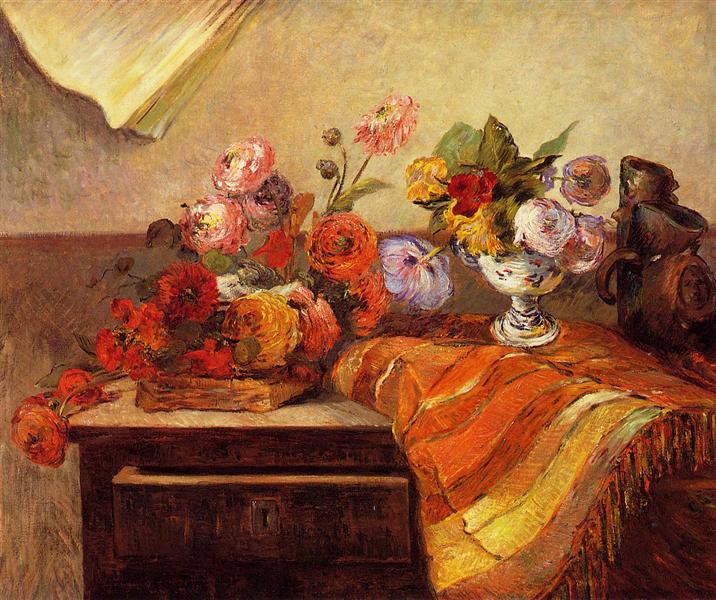Descrizione
Il dipinto "Pots and Bouquets" (1886) di Paul Gauguin è un esempio emblematico dell'evoluzione dell'artista verso il simbolismo e la sperimentazione con forma e colore. In questa tabella, Gauguin mostra una ricca diversità di elementi che invitano una profonda contemplazione delle relazioni tra gli oggetti rappresentati e i significati sottostanti che possono essere evocati da loro. Questo lavoro fa parte della prima produzione di Gauguin, un periodo segnato dalla sua ricerca di stili che si allontanerebbero dal naturalismo a cui era stato regolato nei suoi inizi.
La composizione di "vasi e bouquet" è intrigante: in primo piano, predominano le forme dei contenitori con bouquet di fiori, che dà un senso di profondità e allo stesso tempo di intimità. La disposizione degli elementi è meticolosamente studiata. I colori vibranti - giallo, verde e blu - si combinano per creare un effetto quasi ornamentale in cui la natura dei vasi e dei bouquet si trasforma in una danza cromatica. I vasi, che presentano contorni curvilinei, contrastano fortemente con le linee più organiche di fiori, suggerendo una tensione tra artificiale e naturale.
I colori in "vasi e bouquet" diventano la loro lingua. La tavolozza ricca e comprovata è caratteristica dello stile post -impressionista sviluppato da Gauguin, che deliberatamente si allontanava dai convenzionali laureati di impressionismo per esplorare gli aspetti emotivi ed espressivi del colore. I terribili toni dei vasi lasciano il posto alla freschezza vivente dei fiori, che sembrano esplodere dal tessuto, ciascuno assunto nella sua unicità, ma anche come parte di un set più ampio che trascende la semplice rappresentazione.
A livello tematico, l'assenza di figure umane suggerisce una contemplazione del mondo domestico e la bellezza dell'ambiente quotidiano, un approccio che Gauguin ha elaborato in alcune delle sue opere successive. Tuttavia, nonostante la mancanza di figure, c'è un senso della vita nel dipinto che potrebbe riferirsi all'esperienza umana attraverso la natura e gli oggetti. Gli inanimati - i vasi - e i vivi - i fiori - una conversazione silenziosa che parla della connessione tra esseri umani e ciò che li circonda.
Questo lavoro ci offre anche uno sguardo allo sviluppo dell'estetica di Gauguin, in cui sono apprezzate le influenze della pittura giapponese e dell'arte popolare, elementi che l'artista ha coltivato dopo il suo soggiorno in Bretagna. La semplificazione delle forme e l'uso di colori piatti rivelano la sua inclinazione verso un dipinto più simbolico, in cui la scelta di ciascun elemento è deliberata e carica di significato. Questo approccio anticipa gli elementi che sarebbero stati visti nelle loro successive opere a Tahiti, in cui l'esplorazione della cultura, dell'identità e del simbolismo locale dominerebbe la sua produzione.
Infine, "Ollas Y Ramos" è un'opera che non solo cattura lo sguardo dello spettatore attraverso la sua bellezza estetica, ma lo invita anche a riflettere sul contesto in cui si trova e sulle visioni del mondo che Gauguin stava iniziando a svilupparsi, quindi rivelando il suo luogo essenziale nel dialogo artistico della fine del diciannovesimo secolo. La pittura non è semplicemente un record visivo; È una testimonianza del passare del tempo, della percezione dello spazio umano e della ricerca di una connessione più profonda con la natura e l'esistenza stessa.
KUADROS ©, una famosa vernice sul muro.
Dipinti ad olio fatti a mano, con la qualità degli artisti professionisti e il distintivo sigillo di KUADROS ©.
Servizio di riproduzione delle immagini con garanzia di soddisfazione. Se non sei completamente soddisfatto della replica del tuo dipinto, rimborsiamo i tuoi soldi al 100%.

